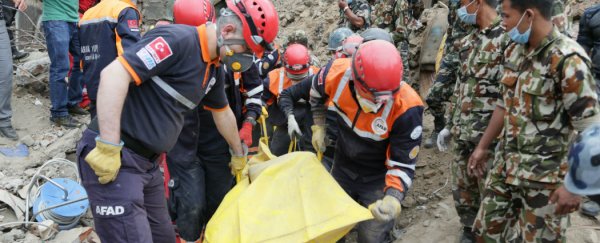Four men buried alive in Nepal under three metres (10 feet) of mud and rubble have been rescued thanks to an ultra-sensitive radar technology developed by NASA, which detected their heartbeats.
The portable FINDER device is based on remote-sensing technology that's been used to search for signs of life on exoplanets, locate spacecraft in deep space, and to help the Cassini mission analyse the internal structure of Saturn.
It works by bouncing microwaves off an object and analysing the returning signal, and uses sophisticated algorithms, which are capable of filtering out 'noise' to detect even the faintest disturbance or motion. For search and rescue operations, this means trying to detect inaudible breaths and heartbeats from beneath twisted and shattered wreckage.
Following the devastating 7.8 magnitude earthquake in Nepal on April 25, which has already claimed more than 8,000 lives and resulted in billions of dollars worth of damage, two prototype FINDER devices were deployed to help find survivors in a hard-hit region north east of Kathmandu.
As Julie McCarthy reports for NPR:
"The earthquake has flattened the towns along this popular pass. No house, no business appears to have withstood the fury of the quake in the village of Chautara, which straddles a winding, mountainous road. It's the seat of Sindupalchowk, the district that lost the greatest number of people in the quake - some 2,600, or a third of the entire country's fatalities."
Using FINDER, search teams were able to detect two heartbeats, underneath two different collapsed structures in Chautara, allowing rescue workers to dig through the rubble and save four men, who had been trapped for days.
"The true test of any technology is how well it works in a real-life operational setting," Reginald Brothers, from the US Department of Homeland Security's (DHS) Science and Technology Directorate, said in a press release. "Of course, no one wants disasters to occur, but tools like this are designed to help when our worst nightmares do happen. I am proud that we were able to provide the tools to help rescue these four men."
The US DHS developed the technology in partnership with NASA's Jet Propulsion Laboratory, which previously demonstrated that the FINDER device could identify signs of life from people buried under 9 metres (30 feet) of rubble, or hidden behind 6 metres (20 feet) of solid concrete.
The latest version has also been equipped with a new 'GPS' style feature, which, after confirming a heartbeat, can guess the approximate location of a survivor to within about five metres - though officials say the accuracy depends on the type of rubble.
Volunteers have already helped rescue efforts by mapping data points in affected areas. But the value of a technology like this is important on the ground.
In a disaster zone, particularly in a place like Nepal, where poor transport infrastructure and mountainous geography means large swathes of land and villages are largely inaccessible to aid workers, resources are scant.
Being able to detect even a whisper of breath, or a heartbeat, means search and rescue teams that are massively undermanned can target their efforts more effectively to save lives.
